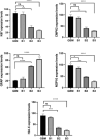Boric acid impedes glioblastoma growth in a rat model: insights from multi-approach analysis
- PMID: 39821858
- PMCID: PMC11742329
- DOI: 10.1007/s12032-025-02600-z
Boric acid impedes glioblastoma growth in a rat model: insights from multi-approach analysis
Abstract
Limited advancements in managing malignant brain tumors have resulted in poor prognoses for glioblastoma (GBM) patients. Standard treatment involves surgery, radiotherapy, and chemotherapy, which lack specificity and damage healthy brain tissue. Boron-containing compounds, such as boric acid (BA), exhibit diverse biological effects, including anticancer properties. This study aimed to examine whether boron supplementation, as BA, can inhibit glioblastoma growth in a xenograft animal model. Using MRI-based tumor size measurement, survival rates, hematological, clinical biochemistry analyses, and genotoxicity parameters, we assessed the impact of BA. Histopathological, immunohistochemical, and immunofluorescence examinations were also conducted. All BA doses (3.25, 6.5, and 13 mg kg-1 b.w.) extended survival compared to GBM controls after 14 days, with a dose-dependent anti-GBM effect observed in MRI analyses. BA treatment improved hematological (WBC and PLT counts) and biochemical parameters (LDL-C, CREA, and ALP). Histopathological examination revealed a significant reduction in tumor diameter with 6.5 and 13 mg kg-1 BA. Immunohistochemical and immunofluorescence staining showed modulation of intracytoplasmic Ki67, cytoplasmic CMPK2, and GFAP expressions in tumor cells post-BA treatment. Additionally, BA did not increase micronuclei formations, indicating its non-genotoxic nature. In conclusion, targeting tumor suppressor networks with boron demonstrates significant therapeutic potential for GBM treatment.
Keywords: Anticancer; Boric acid; Boron; Glioblastoma; Xenograft rat model.
© 2025. The Author(s).
Conflict of interest statement
Declarations. Conflict of interest: Hasan Turkez is one of the co-founders of Bash Biotech Inc (USA). The other authors declare no conflict of interest.
Figures










Similar articles
-
Promising potential of boron compounds against Glioblastoma: In Vitro antioxidant, anti-inflammatory and anticancer studies.Neurochem Int. 2021 Oct;149:105137. doi: 10.1016/j.neuint.2021.105137. Epub 2021 Jul 19. Neurochem Int. 2021. PMID: 34293392
-
Combined acetyl-11-keto-β-boswellic acid and radiation treatment inhibited glioblastoma tumor cells.PLoS One. 2018 Jul 3;13(7):e0198627. doi: 10.1371/journal.pone.0198627. eCollection 2018. PLoS One. 2018. PMID: 29969452 Free PMC article.
-
Boric acid Increases Susceptibility to Chemotherapy by Targeting the Ferritinophagy Signaling Pathway in TMZ Resistant Glioblastoma Cells.Biol Trace Elem Res. 2024 Aug;202(8):3574-3587. doi: 10.1007/s12011-023-03930-7. Epub 2023 Oct 31. Biol Trace Elem Res. 2024. PMID: 37906374
-
Biomimetic models to examine microenvironmental regulation of glioblastoma stem cells.Cancer Lett. 2018 Aug 10;429:41-53. doi: 10.1016/j.canlet.2018.05.007. Epub 2018 May 8. Cancer Lett. 2018. PMID: 29746930 Review.
-
The effects of cannabinoids on glioblastoma growth: A systematic review with meta-analysis of animal model studies.Eur J Pharmacol. 2020 Jun 5;876:173055. doi: 10.1016/j.ejphar.2020.173055. Epub 2020 Mar 4. Eur J Pharmacol. 2020. PMID: 32145324
References
-
- Aghajani M, Jalilzadeh N, Aghebati-Maleki A, Yari A, Tabnak P, Mardi A, et al. Current approaches in glioblastoma multiforme immunotherapy. Clin Transl Oncol. 2024;26:1584–612. - PubMed
MeSH terms
Substances
LinkOut - more resources
Full Text Sources
Medical
Miscellaneous

